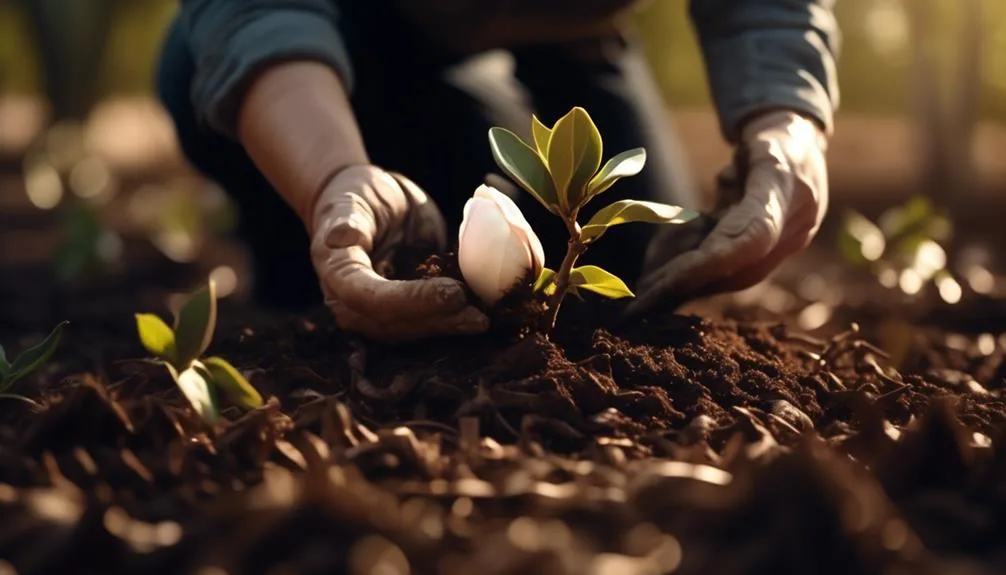Thinking about planting a magnolia tree? Whether you're a seasoned gardener or just starting out, nurturing this beautiful tree is an exciting challenge. With the right guidance, you can create a stunning landscape feature that will impress your neighbors.
Before you start planting, there are some important tips to ensure your magnolia tree thrives.
Selecting the Right Location
When selecting the right location for planting your magnolia tree, consider choosing a spot that receives full to partial sunlight and has well-drained soil to ensure optimal growth and blooming.
Magnolia trees thrive in well-drained, slightly acidic to neutral soil. Sandy or loamy soils are ideal for magnolias, as they provide good drainage, which is crucial for the tree's health. Additionally, avoid areas with compacted or waterlogged soil, as this can lead to root rot and other diseases.
In terms of sun exposure, magnolias generally prefer full sun to partial shade. They need at least six hours of direct sunlight a day to bloom profusely. However, in hotter climates, providing some afternoon shade can help prevent stress on the tree.
Selecting the right location with the correct soil type and sun exposure is fundamental for the successful growth and development of your magnolia tree.
Preparing the Planting Site
To prepare the planting site for your magnolia tree, clear the area of any debris, including rocks, weeds, and other competing vegetation, to create a clean and well-defined space for optimal growth.
Once the area is clear, consider the soil preparation. Magnolia trees thrive in well-draining, slightly acidic soil. Test the soil pH and amend it if necessary with organic matter like compost or peat moss.
Ensure the site receives adequate sunlight, as magnolias generally prefer full sun to partial shade. Adequate sunlight is crucial for the tree's overall health and flowering.
Also, consider the drainage considerations. Magnolia trees don't tolerate waterlogged soil well, so it's essential to choose a site with good drainage to prevent root rot.
Planting the Magnolia Tree
Prepare the planting hole for your magnolia tree by digging a wide and shallow area that's at least twice the diameter of the root ball.
When planting the magnolia tree, consider the following:
- Soil Composition: Ensure the soil is well-draining and slightly acidic, with a pH level between 5.0 and 6.5. Mix in organic matter like compost to improve soil structure and fertility.
- Seasonal Timing: Plant your magnolia tree in late winter or early spring, just before the growing season begins. This timing allows the tree to establish its roots before the heat of summer or the cold of winter sets in.
- Planting Depth: Place the magnolia tree in the center of the hole, making sure the top of the root ball is slightly above ground level. Backfill the hole with the soil mixture, gently tamping it down as you go to remove air pockets.
Following these steps will ensure that your magnolia tree gets off to a healthy start.
Watering and Mulching
Consider watering your newly planted magnolia tree deeply and regularly to ensure proper hydration. This is especially crucial during the tree's first growing season. Aim to keep the soil consistently moist, but not waterlogged.
Mulching is equally important. Applying a layer of mulch around the base of the tree offers several benefits. It helps to retain moisture in the soil, reducing the frequency of watering needed. Additionally, mulch regulates soil temperature, keeping it cooler in the summer and providing insulation in the winter. Organic mulches, such as wood chips or shredded bark, can also improve soil fertility as they decompose.
When mulching, ensure it's spread evenly around the tree, extending out to the drip line but not directly against the trunk.
This combination of proper watering and mulching will greatly contribute to the healthy growth of your magnolia tree.
Caring for Young Magnolia Trees
When caring for young magnolia trees, ensure they receive adequate sunlight for healthy growth and development. Magnolias thrive in full sunlight, preferably in well-drained soil.
Here are some essential tips for caring for young magnolia trees:
- Pruning Techniques: Proper pruning is crucial for shaping the tree and promoting healthy growth. Trim any dead or damaged branches and remove any crossed branches to allow for better air circulation.
- Pest Control: Keep an eye out for common pests such as scale insects and magnolia scale. Apply horticultural oil in early spring to suffocate overwintering pests and prevent infestations.
- Fertilization: Young magnolia trees benefit from regular fertilization during their growing season. Use a balanced fertilizer to support their overall health and vigor.
Conclusion
With these top planting tips for magnolia trees, you're set to choose the perfect spot, prepare the soil, and nurture your tree for thriving blooms.
Here's to a flourishing magnolia in your garden, enriching your outdoor space for years to come.
Happy planting!

My interest in trees started when I first saw the giant sequoias in Yosemite.
I was a teenager then, and I remember thinking, “I need to learn more about this.”
That moment stuck with me.
A few years later, I went on to study forestry at Michigan Tech.
Since graduating, I’ve worked in a mix of hands-on tree care and community education.
I’ve spent over ten years helping people understand how to plant, maintain, and protect the trees in their neighborhoods.
I don’t see trees as just part of the landscape.
They are living things that make a real difference in our daily lives.
